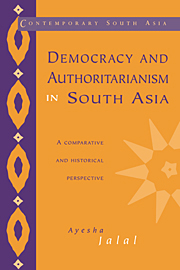Book contents
- Frontmatter
- Contents
- List of maps
- Preface
- Introduction
- 1 The colonial legacy in India and Pakistan
- 2 State formation and political processes in India and Pakistan, 1947 to c.1971
- 3 The ‘populist’ era and its aftermath in India, Pakistan and Bangladesh, 1971 to c.1993
- 4 The state and political economy, 1947 to c.1993
- 5 Central power and regional dissidence
- 6 Societies, cultures and ideologies: hybrids in contrived monoliths
- 7 Conclusion
- Bibliographical essay
- Index
Preface
Published online by Cambridge University Press: 26 October 2009
- Frontmatter
- Contents
- List of maps
- Preface
- Introduction
- 1 The colonial legacy in India and Pakistan
- 2 State formation and political processes in India and Pakistan, 1947 to c.1971
- 3 The ‘populist’ era and its aftermath in India, Pakistan and Bangladesh, 1971 to c.1993
- 4 The state and political economy, 1947 to c.1993
- 5 Central power and regional dissidence
- 6 Societies, cultures and ideologies: hybrids in contrived monoliths
- 7 Conclusion
- Bibliographical essay
- Index
Summary
This volume has taken shape during my sojourns at various academic institutions in the United States since 1987, all of which share the credits in different measure. Intellectually it forms a bridge between my earlier monographs and current research on multiple identities and theories of sovereignty in South Asia. The inspiration for it was provided by my students at Wisconsin-Madison, Tufts and, above all, Columbia and it is largely for them that I decided to undertake a work of this level of generality and, hopefully, accessibility.
While teaching South Asian politics at the University of Wisconsin-Madison, I was struck by the absence of any historical and comparative analysis of states and political processes in India, Pakistan and Bangladesh. The arbitrary lines drawn at the time of India's partition in 1947 – the subject of my doctoral research – appeared to have become a mental barrier to a comparative and thematic treatment of post-independence developments in the subcontinent. After completing a study of the first decade of Pakistan's independence, I turned to culling material on post-independence India available in British and American archives. The findings convinced me that the immediate post-independence period in both countries was not only comparable but a key to understanding the divergences in their post-independence history. After the ‘transition’ to democracy in Pakistan and Bangladesh, any comparative exercise had to try and explain why political, social and economic developments in the subcontinent were apparently showing signs of converging.
- Type
- Chapter
- Information
- Democracy and Authoritarianism in South AsiaA Comparative and Historical Perspective, pp. xi - xivPublisher: Cambridge University PressPrint publication year: 1995

